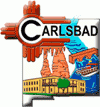Carlsbad (Carlsbad)
 |
Carlsbad is a hub for potash mining, petroleum production, and tourism. Carlsbad Caverns National Park is located 20 mi southwest of the city, and Guadalupe Mountains National Park lies 54 mi southwest across the Texas border. The Lincoln National Forest is to the northwest of town.
The development of southeastern New Mexico in the late 19th century was fueled by the arrival of colonies of immigrants from England, Switzerland, France, and Italy. Located along the banks of the Pecos River, Carlsbad was originally christened the town of Eddy on September 15, 1888, and organized as a municipal corporation in 1893; the settlement bore the name of Charles B. Eddy, co-owner of the Eddy-Bissell Livestock Company. With the commercial development of local mineral springs near the flume for medicinal qualities, the town later voted to change its name to Carlsbad after the famous European spa Carlsbad, Bohemia (now Karlovy Vary, Czech Republic), which in turn was named after Charles IV, Holy Roman Emperor and King of Bohemia. On March 25, 1918, the growing town surpassed a population of 2,000, allowing then-governor of New Mexico Washington Ellsworth Lindsey to proclaim Carlsbad a city.
Most of Carlsbad's development was due to irrigation water. Local cattlemen recognized the value of diverting water from the Pecos River to the grazing lands on Eddy's Halagueno Ranch. Many construction projects were undertaken to establish an irrigation system within the town. The Avalon Dam was constructed upstream of town, and canals diverted the water into town. Conflict arose when the canals met the river downstream; as a result, the Pecos River Flume was built, first out of wood and later concrete (the flume is often titled the only place where a river crosses itself).
Key to the growth of the area was special excursion trains that brought visitors from the East at reduced fares. Before the Pecos Valley Railroad arrived in 1891, travel parties met at the railroad station in Toyah, Texas, and were driven by buggy 90 mi over a rough, dusty road to this small but growing settlement on the banks of the Pecos River. Most of the early construction in Carlsbad was completed with locally manufactured bricks. The bricks were quite soft and of poor quality. The former First National Bank building at the corner of Canal and Fox streets is one of the few remaining buildings constructed with local brick. The re-discovery of Carlsbad Caverns (then known as "Bat Cave") by local cowboys in 1901 and the subsequent establishment of Carlsbad Caverns National Park on May 14, 1930, gained the town of Carlsbad substantial recognition.
In 1925, potash was discovered near Carlsbad, and for many years Carlsbad dominated the American potash market. Following the decline of the potash market in the 1960s, the residents and leaders of Carlsbad lobbied for the establishment of the Waste Isolation Pilot Plant (WIPP), a site where low-level nuclear waste would be stored thousands of feet underground in salt beds. Congress authorized the WIPP project in 1979, and construction began in 1980. The DOE Carlsbad Area Office opened in 1993, and the first waste shipment arrived in 1999.
Currently, Carlsbad has experienced a "boom". The city is leading in the production of oil and natural gases across the entire area, causing an increase in the employment rate. Due to this increase families and individuals have begun to migrate to Carlsbad.
Map - Carlsbad (Carlsbad)
Map
Country - United_States
 |
 |
| Flag of the United States | |
Indigenous peoples have inhabited the Americas for thousands of years. Beginning in 1607, British colonization led to the establishment of the Thirteen Colonies in what is now the Eastern United States. They quarreled with the British Crown over taxation and political representation, leading to the American Revolution and proceeding Revolutionary War. The United States declared independence on July 4, 1776, becoming the first nation-state founded on Enlightenment principles of unalienable natural rights, consent of the governed, and liberal democracy. The country began expanding across North America, spanning the continent by 1848. Sectional division surrounding slavery in the Southern United States led to the secession of the Confederate States of America, which fought the remaining states of the Union during the American Civil War (1861–1865). With the Union's victory and preservation, slavery was abolished nationally by the Thirteenth Amendment.
Currency / Language
| ISO | Currency | Symbol | Significant figures |
|---|---|---|---|
| USD | United States dollar | $ | 2 |
| ISO | Language |
|---|---|
| EN | English language |
| FR | French language |
| ES | Spanish language |















